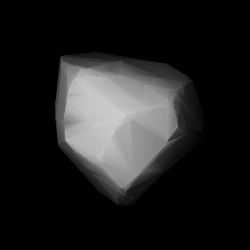Astronomy:5208 Royer
 Shape model of Royer from its lightcurve | |
| Discovery [1] | |
|---|---|
| Discovered by | E. F. Helin |
| Discovery site | Palomar Obs. |
| Discovery date | 6 February 1989 |
| Designations | |
| (5208) Royer | |
| Named after | Msgr Ronald E. Royer [1] (American priest and amateur astronomer) |
| 1989 CH1 | |
| Minor planet category | main-belt [1][2] · (middle) Maria [3] |
| Orbital characteristics [2] | |
| Epoch 23 March 2018 (JD 2458200.5) | |
| Uncertainty parameter 0 | |
| Observation arc | 64.29 yr (23,481 d) |
| |{{{apsis}}}|helion}} | 2.7241 AU |
| |{{{apsis}}}|helion}} | 2.4844 AU |
| 2.6042 AU | |
| Eccentricity | 0.0460 |
| Orbital period | 4.20 yr (1,535 d) |
| Mean anomaly | 345.72° |
| Mean motion | 0° 14m 4.2s / day |
| Inclination | 15.904° |
| Longitude of ascending node | 124.56° |
| 21.407° | |
| Physical characteristics | |
| Mean diameter | 7.884±0.150 km[4] 8.081±0.121 km[5] 9.40 km (calculated)[6] |
| Rotation period | 3.866 h[7] 3.88494±0.00005 h[8] |
| Geometric albedo | 0.20 (assumed)[6] 0.270±0.059[5] 0.2854±0.0197[4] |
| SMASS = S [2][6] | |
| Absolute magnitude (H) | 12.5[4][6] 12.6[2] |
5208 Royer (prov. designation: 1989 CH1) is a stony Marian asteroid from the central regions of the asteroid belt, approximately 8 kilometers (5 miles) in diameter. It was discovered on 6 February 1989, by astronomer Eleanor Helin at the Palomar Observatory. The S-type asteroid has a rotation period of 3.87 hours and was named after American priest and amateur astronomer, Ronald Royer.[1][6]
Orbit and classification
Royer is a member of the Maria family (506),[3] a large family of stony asteroids with nearly 3,000 known members.[9]:23
It orbits the Sun in the central asteroid belt at a distance of 2.5–2.7 AU once every 4 years and 2 months (1,535 days; semi-major axis of 2.6 AU). Its orbit has an eccentricity of 0.05 and an inclination of 16° with respect to the ecliptic.[2] The body's observation arc begins with a precovery taken at Palomar Observatory in November 1953, more than 35 years prior to its official discovery observation.[1]
Naming
This minor planet was named after Reverend Ronald E. Royer, an American priest as well as amateur astronomer and astrophotographer.[1] He has been a member of the Los Angeles Astronomical Society (LAAS) since 1946 and received the G. Bruce Blair Award in 2001.[10] The official naming citation was published by the Minor Planet Center on 6 April 1993 (M.P.C. 21957).[11]
Physical characteristics
In the SMASS classification, Royer is a common, stony S-type asteroid.[2][6]
Rotation period and poles
In 2004, a rotational lightcurve of Royer was obtained from photometric observations by Brazilian and Argentine astronomers. Lightcurve analysis gave a rotation period of 3.866 hours with a brightness amplitude of 0.44 magnitude ({{{1}}}).[7] In 2016, a modeled lightcurves using photometric data from various sources, rendered a sidereal period of 3.88494 and two spin axes of (258.0°, 74.0°) and (54.0°, 37.0°) in ecliptic coordinates.[8]
Diameter and albedo
According to the survey carried out by the NEOWISE mission of NASA's Wide-field Infrared Survey Explorer, Royer measures 7.884 and 8.081 kilometers in diameter and its surface has an albedo of 0.2854 and 0.270, respectively,[4][5] while the Collaborative Asteroid Lightcurve Link assumes a standard albedo for stony asteroids of 0.20 and calculates a diameter of 9.40 kilometers based on an absolute magnitude of 12.5.[6]
References
- ↑ 1.0 1.1 1.2 1.3 1.4 1.5 "5208 Royer (1989 CH1)". Minor Planet Center. https://www.minorplanetcenter.net/db_search/show_object?object_id=5208.
- ↑ 2.0 2.1 2.2 2.3 2.4 2.5 "JPL Small-Body Database Browser: 5208 Royer (1989 CH1)". Jet Propulsion Laboratory. https://ssd.jpl.nasa.gov/sbdb.cgi?sstr=2005208.
- ↑ 3.0 3.1 "Asteroid 5208 Royer – Nesvorny HCM Asteroid Families V3.0". Small Bodies Data Ferret. https://sbntools.psi.edu/ferret/SimpleSearch/results.action?targetName=5208+Royer#Asteroid%205208%20RoyerEAR-A-VARGBDET-5-NESVORNYFAM-V3.0.
- ↑ 4.0 4.1 4.2 4.3 Mainzer, A.; Grav, T.; Masiero, J.; Hand, E.; Bauer, J.; Tholen, D. et al. (November 2011). "NEOWISE Studies of Spectrophotometrically Classified Asteroids: Preliminary Results". The Astrophysical Journal 741 (2): 25. doi:10.1088/0004-637X/741/2/90. Bibcode: 2011ApJ...741...90M.
- ↑ 5.0 5.1 5.2 Masiero, Joseph R.; Mainzer, A. K.; Grav, T.; Bauer, J. M.; Cutri, R. M.; Dailey, J. et al. (November 2011). "Main Belt Asteroids with WISE/NEOWISE. I. Preliminary Albedos and Diameters". The Astrophysical Journal 741 (2): 20. doi:10.1088/0004-637X/741/2/68. Bibcode: 2011ApJ...741...68M.
- ↑ 6.0 6.1 6.2 6.3 6.4 6.5 6.6 "LCDB Data for (5208) Royer". Asteroid Lightcurve Database (LCDB). http://www.minorplanet.info/PHP/generateOneAsteroidInfo.php?AstInfo=5208%7CRoyer.
- ↑ 7.0 7.1 Alvarez-Candal, Alvaro; Duffard, René; Angeli, Cláudia A.; Lazzaro, Daniela; Fernández, Silvia (December 2004). "Rotational lightcurves of asteroids belonging to families". Icarus 172 (2): 388–401. doi:10.1016/j.icarus.2004.06.008. Bibcode: 2004Icar..172..388A.
- ↑ 8.0 8.1 Hanuš, J.; Ďurech, J.; Oszkiewicz, D. A.; Behrend, R.; Carry, B.; Delbo, M. et al. (February 2016). "New and updated convex shape models of asteroids based on optical data from a large collaboration network". Astronomy and Astrophysics 586: A108. doi:10.1051/0004-6361/201527441. ISSN 0004-6361. Bibcode: 2016A&A...586A.108H.
- ↑ Nesvorný, D.; Broz, M.; Carruba, V. (December 2014). "Identification and Dynamical Properties of Asteroid Families". Asteroids IV. pp. 297–321. doi:10.2458/azu_uapress_9780816532131-ch016. ISBN 9780816532131. Bibcode: 2015aste.book..297N.
- ↑ "2001 G. Bruce Blair Award – Rev. Monsignor Ronald E. Royer". Western Amateur Astronomers. http://www.waa.av.org/RonRoyer_page.html.
- ↑ "MPC/MPO/MPS Archive". Minor Planet Center. https://www.minorplanetcenter.net/iau/ECS/MPCArchive/MPCArchive_TBL.html.
External links
- Royer Oaks Observatory, in Springville, California
- Holy Cross Church, Porterville, January 2012
- Lightcurve Database Query (LCDB), at www.minorplanet.info
- Dictionary of Minor Planet Names, Google books
- Discovery Circumstances: Numbered Minor Planets (5001)-(10000) – Minor Planet Center
- 5208 Royer at AstDyS-2, Asteroids—Dynamic Site
- 5208 Royer at the JPL Small-Body Database
 |

